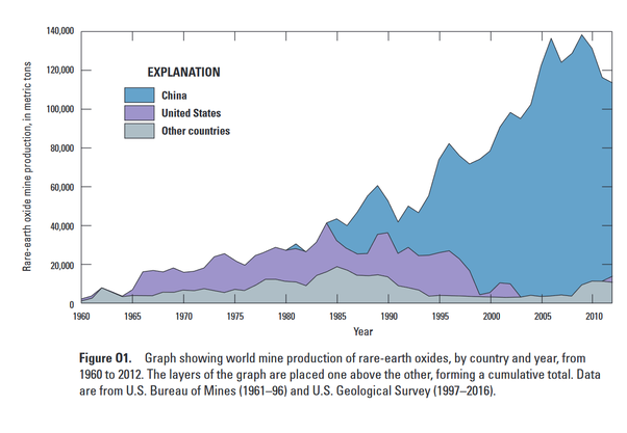Have you heard of #RareEarth or #REE metals, but want to know what they are? Here is a short primer on the “what”, “where” and “why” of REEs from a global perspective...
First, what are #REE and what do we need them for? Rare Earth metals are 17 elements comprised of 15 lanthanides, as well as scandium (Sc) and yttrium (Y).
They can be divided into groups of light REE (LREE) and heavy REE (HREE), however, there is no consensus on which elements belong in which group. Also, sometimes Sc is omitted as a REE in some studies.
#RareEarths are not so rare in the Earth’s crust as they are in the economy. This is because they are very expensive to develop, mostly due to low concentration.
They share a similar chemistry, which means they tend to occur together, however, they are also difficult to separate from each other.
These metals are critical for many of our advanced commercial technologies, including EVs, batteries, wind turbines, fluorescent lighting, cell phones, medical devices, aerospace and defense, to name a few. They are also very difficult to substitute.
Are #RareEarths brand new? No. They have been around for decades. For example, scandium has been alloyed with aluminum to produce light-weight aluminum baseball bats in the US since the 90s. https://www.justbats.com/blog/post/10-common-misconceptions-about-baseball-bats/.
The global annual production of #REE is usually expressed as rare earth oxides (REO) and is estimated to be approximately 210,000 tonnes in 2019 by the USGS. https://pubs.usgs.gov/periodicals/mcs2020/mcs2020-rare-earths.pdf. Compare this to approximately 1.9 billion tonnes of raw steel produced annually.
Where? Well, at one point the US was the top producer, but that changed in the 80s and China became the global supplier of #RareEarths. https://www.quora.com/Why-does-the-USGS-estimate-the-US-has-tiny-rare-earth-mineral-reserves-even-though-the-country-is-well-endowed-with-other-mineral-and-natural-resources
Today, China still produces and refines over 60% of global #RareEarth supply, however, Malaysia and Australia are significant players, and the US is increasing production as well. https://pubs.usgs.gov/periodicals/mcs2020/mcs2020-rare-earths.pdf
Why does it matter where they are produced? Well for one thing #REE production is environmentally intense.
https://www.sciencedirect.com/science/article/abs/pii/S0921344919305816?via%3Dihub
http://aloki.hu/pdf/1702_43434359.pdf https://www.sciencedirect.com/science/article/pii/S0301420714000282?via%3Dihub
https://www.sciencedirect.com/science/article/abs/pii/S0921344919305816?via%3Dihub
http://aloki.hu/pdf/1702_43434359.pdf https://www.sciencedirect.com/science/article/pii/S0301420714000282?via%3Dihub
Perhaps more relevant to development is that they are required by the world’s defense agencies, including the US military, and societal and geo-political factors have been identified as potential supply chain disruptors.
https://www.politico.com/news/2020/08/03/pentagon-rare-earth-minerals-china-390939.
https://www.sciencedirect.com/science/article/pii/S092134491830435X.
https://www.politico.com/news/2020/08/03/pentagon-rare-earth-minerals-china-390939.
https://www.sciencedirect.com/science/article/pii/S092134491830435X.
So why do we care about #RareEarths? We know we need them in our high-tech industries, including renewable energy and EVs, and we expect these industries to grow rapidly. From a climate perspective, many countries are counting on it.
This means we are going to need a lot more #RareEarths, fast. Given that they are polluting, geographically concentrated in production, and prone to geopolitical disruption, it is not an easy problem to solve, especially if we want to solve it quickly and economically.
Add to that the balance problem. #REEs naturally occur together in differing proportions. In the economy, however, they each have specific utility and if the market demands a certain amount of a critical material, at least enough ore to provide that material must be processed.
This results in industries trying to find new uses for #REE that are available in excess and substitutions for those that in low supply or high demand. https://link.springer.com/article/10.1007/s40831-018-0162-8
Finally, there is no agreed upon price standard for #RareEarths. Therefore, consultants can use different prices to evaluate same plays and come to different conclusions about economic feasibility. https://born2invest.com/articles/the-rare-earth-element-basket-price-deception/
So, to summarize, #RareEarths are expensive and polluting to produce, difficult to scale, and are prone to geopolitical and physical shortages in the current supply chain. At the same time, we are going to need a lot more of them! What do we do?

 Read on Twitter
Read on Twitter



